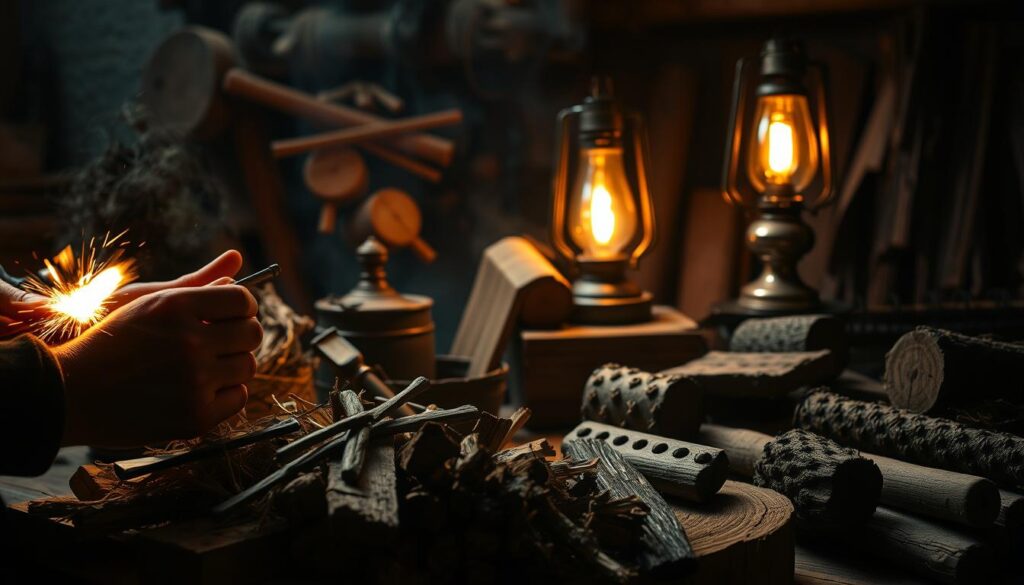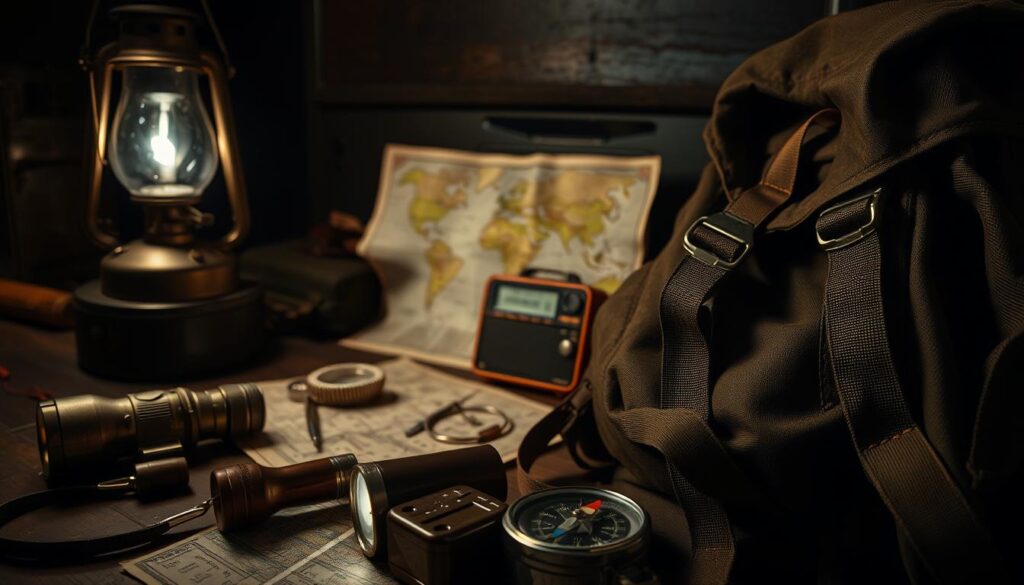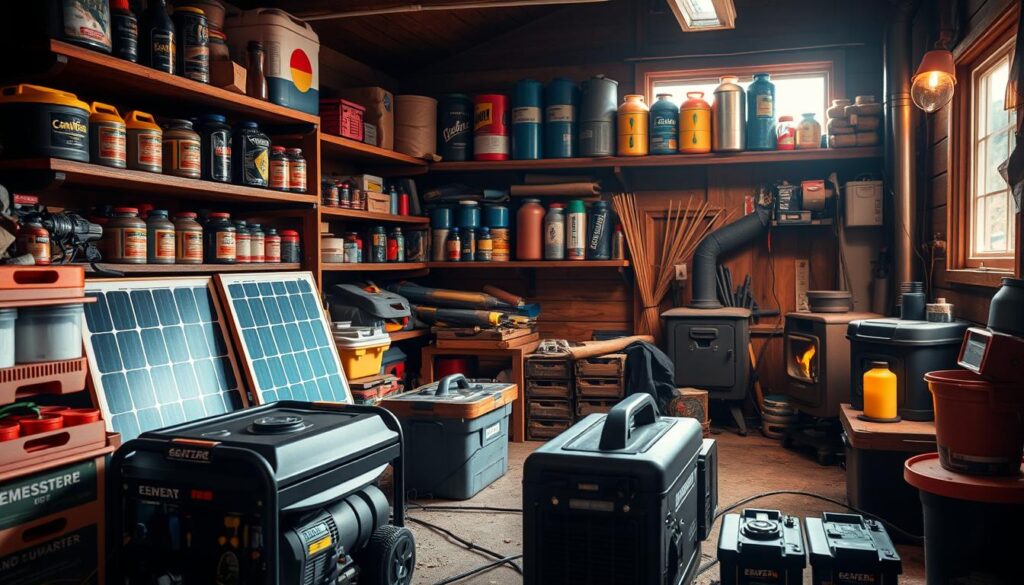Starting a fire from natural materials is truly magical. I remember teaching my friends how to make a fire using a bow drill or ferro rod. They were amazed by how simple and beautiful it was.
For me, making a fire is more than just survival. It’s an art that needs patience, skill, and lots of practice. After years of learning, I’m ready to share my best fire lighting techniques with you.
Key Takeaways
- Learn the art of starting a fire using natural materials
- Discover the most effective fire-making methods
- Understand the importance of practice in mastering fire lighting
- Explore the use of tools like bow drill and ferro rod
- Improve your bushcraft skills with simple techniques
Understanding the Basics of Fire
To light a fire, you need to know the basics. These basics are key to mastering fire starting methods and getting a fire going right.
The Importance of Fire in Survival Situations
Fire is vital in survival situations. It gives warmth, light, and a way to cook food. Having a reliable fire start can be a lifesaver. It’s not just for comfort; it can also signal for help and purify water.
- Provides warmth in cold environments
- Offers a method for cooking food, making it safer to eat
- Serves as a signal for rescue teams
- Can be used for purifying water
Fire Triangle: Heat, Fuel, and Oxygen
The fire triangle, also known as the combustion triangle, has three key parts: heat, fuel, and oxygen. Knowing how these elements work together is key to starting a fire well.
The right mix of oxygen, fuel, and heat is essential for starting a fire. Too little or too much of any can stop a fire from starting or make it go out.
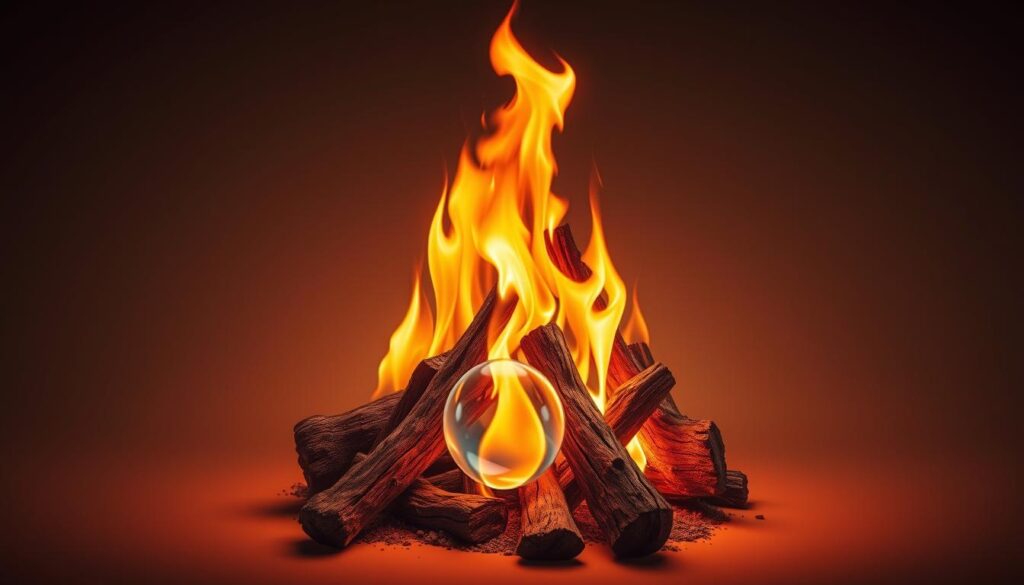
Safety Precautions When Starting a Fire
When starting a fire, safety comes first. Choose a safe spot, away from things that can catch fire. Also, have a plan to put out the fire when it’s done.
- Clear the area of leaves, branches, and other combustible materials.
- Have a bucket of water or a fire extinguisher nearby.
- Monitor wind conditions to prevent the fire from spreading.
By knowing the basics of fire and being careful, you can start a fire safely and successfully. This way, you’ll master the best way to light a fire for your needs.
Essential Tools for Fire Lighting
Starting a fire is all about the tools you pick. It’s key to know the difference between various tools and materials. This knowledge helps you light a fire successfully.
Recommended Fire Starting Gear
There are many fire starting tools out there. From simple matches to complex ferrocerium rods, each has its own strengths. Ferrocerium rods are great because they spark even when it’s wet. Always have a backup, like waterproof matches or a lighter, ready for any situation.
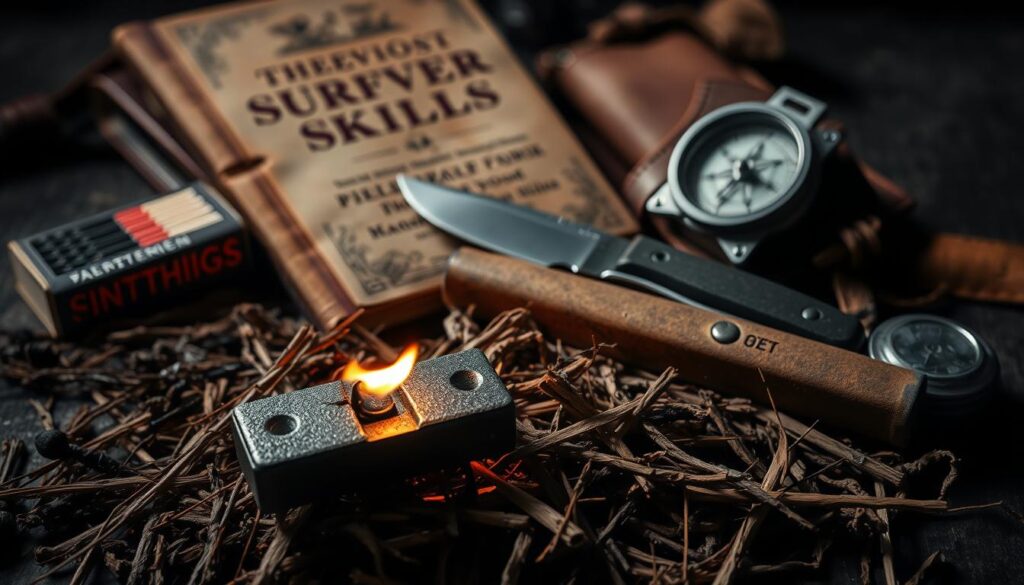
Natural vs. Synthetic Materials
Choosing between natural and synthetic materials depends on where you are and what you like. Natural materials like dry leaves and twigs are easy to find outdoors. They work well in many places. But, synthetic materials like dryer lint or wax starters are better in wet or damp areas.
| Material Type | Advantages | Disadvantages |
|---|---|---|
| Natural Materials | Readily available, biodegradable | Can be damp, less reliable |
| Synthetic Materials | Reliable, works in damp conditions | Not biodegradable, may produce toxic fumes |
The Role of Kindling and Tinder
Kindling and tinder are key to starting a fire. Kindling are small sticks that help grow the fire. Tinder is dry, flammable material like leaves that ignites first. Having enough of both is vital for a successful fire.
To light a fire well, follow fire making tips. Know how to use your tools and materials right. With the right gear and knowledge, you’ll soon be able to ignite a fire anywhere.
Fire Lighting Techniques for Beginners
Starting a fire can seem hard for beginners, but it gets easier with practice. Learning easy fire ignition techniques is key for a great camping trip. Here, I’ll share simple ways to start your campfire.
The Hand Drill Method
The hand drill method is old but rewarding. It makes heat by rubbing sticks together. You need a fireboard, a drill, and tinder to start. Patience is key because it takes time and effort.
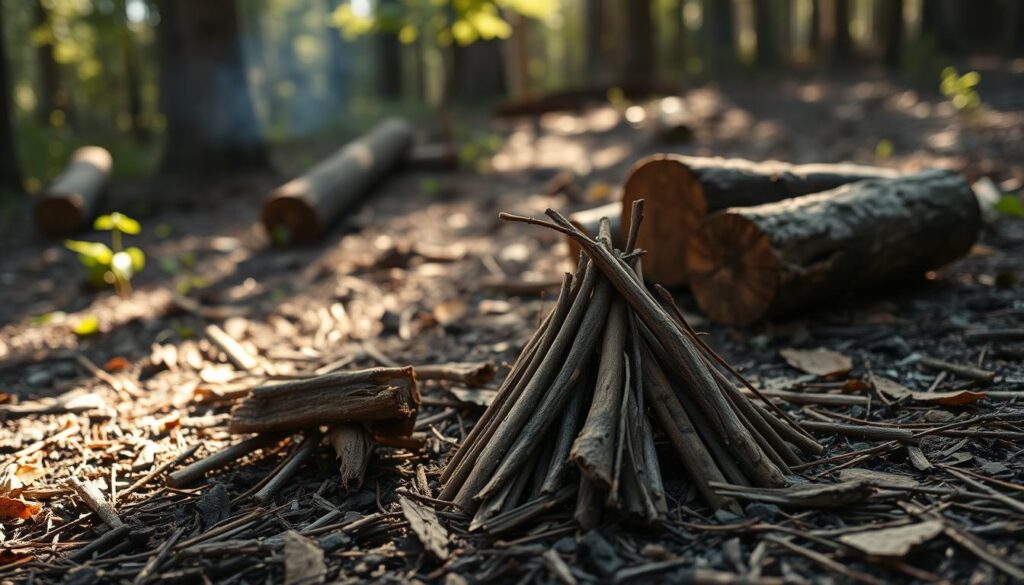
Using a Fire Starter Kit
Using a fire starter kit is easier. These kits have a ferrocerium rod and a striker. To use it, place tinder where you want the fire. Hold the rod at a 30-40 degree angle and strike it to make sparks.
Lighting a Fire with Matches
Lighting a fire with matches is simple and fast. It needs little equipment. Prepare tinder and kindling, light a match, and hold it to the tinder. Then, add more kindling to grow the fire.
It’s important to practice campfire techniques to get good at them. Always make sure you’re in a safe place and follow local fire safety rules.
Advanced Fire Lighting Techniques
Advanced fire lighting techniques are not just for survival; they’re also about connecting with nature. As I explore the art of fire lighting, I’m drawn to methods that challenge and reward me. We’ll look at some advanced techniques that outdoor enthusiasts can master.
If you’ve already learned the basics, it’s time to get better. Techniques like the bow drill method and using flint and steel are more complex. They require patience, practice, and a deep understanding of the elements involved.
Bow Drill Method for Experienced Users
The bow drill method is a primitive yet effective way to start a fire. It involves creating friction between two sticks to generate heat and eventually an ember. This method requires setup and practice but is very rewarding.
To master the bow drill, you’ll need a bow, a drill, a fireboard, and a handhold. The process involves looping the bowstring around the drill and moving the bow back and forth to create friction on the fireboard.
“The bow drill is a testament to the ingenuity of our ancestors, who relied on such techniques for survival. It’s a skill that not only provides a practical means of starting a fire but also connects us to our past.”
Fire by Friction: Tips and Tricks
Fire by friction includes the bow drill method and other techniques like the hand drill and the pump drill. The key to success is understanding the principles of friction and heat generation.
Choosing the right wood is critical. Softwoods are better for the drill and fireboard because they are softer and easier to create friction with. Hardwoods are better for the bow and handhold because they are durable.
| Technique | Equipment Needed | Difficulty Level |
|---|---|---|
| Bow Drill | Bow, Drill, Fireboard, Handhold | High |
| Flint and Steel | Flint, Steel Striker | Medium |
| Hand Drill | Drill, Fireboard | Very High |
Using Flint and Steel Effectively
Using flint and steel is another advanced technique that requires practice. The key is to strike the steel against the flint at the correct angle to produce sparks that land on your tinder.
The choice of flint and steel is important. High-carbon steel produces better sparks, and the flint should be hard enough to withstand the striking.
As you practice these advanced fire lighting techniques, you’ll improve your survival skills and appreciate the art of fire starting more. Whether you’re in the wilderness or just camping, these methods will make your experience better and connect you more closely with nature.
Choosing the Right Location for Your Fire
When planning to start a fire, the location is as important as the method. The right spot is essential for a safe and fun outdoor adventure. You need to think about wind direction, terrain, and fuel availability.
Factors to Consider: Wind, Terrain, and Fuel Availability
Wind direction is key because it can spread the fire. I look for a spot protected from strong winds. A flat area is better than a sloping one to prevent fire spread or rain washout.
Also, having dry, combustible material nearby is vital for keeping the fire going.
Setting Up a Safe Fire Ring
To create a safe fire ring, I clear the area of leaves, twigs, and other flammable stuff. In the wilderness, I choose a spot with mineral soil or rock. If fire rings are common, I use an existing one to protect the environment.
Creating a fire ring means arranging rocks in a circle to keep the fire in.
Avoiding Common Pitfalls
One mistake is starting a fire too close to trees or flammable objects. I ensure there’s enough space around the fire to stop it from spreading. It’s also important to have a plan for putting out the fire.
Environmental Considerations
It’s important to know how lighting a fire affects the environment. As outdoor lovers, we must make sure our actions don’t harm nature. We enjoy these places, and we should protect them.
Understanding Fire Regulations and Restrictions
Before starting a fire, learn about local fire rules. These laws help keep the environment safe and protect visitors. Talking to local authorities or park rangers can tell you about fire bans or restrictions.
How to Minimize Environmental Impact
To reduce harm to the environment, follow good fire practices. Use fire rings, keep fires small, and make sure they’re out before leaving. For more tips, check out Mountain House’s guide.
Tips for Fire Safety in Different Seasons
Fire safety changes with the seasons. In dry times, be very careful with fires to avoid wildfires. In wet weather, make sure your fire is lit and kept right. Knowing these differences helps with safe and responsible fire lighting.
Building and Maintaining a Fire
Learning to build and keep a fire is key for survival and fun outdoors. Whether camping, hiking, or in a survival situation, a fire can be a lifesaver.
Log Cabin vs. Teepee Structures
The structure of your fire can greatly affect its burn time and efficiency. There are two main methods: log cabin and teepee structures.
- The log cabin structure is stable and burns longer. It’s made by arranging logs in a crisscross pattern for good airflow.
- The teepee structure is great for quick starts. It’s made by leaning logs in a cone shape.
Both methods have their benefits. Your choice depends on your needs and the situation.
How to Keep a Fire Burning Long-term
To keep a fire going, you need to manage it well. Here are some tips:
- Monitor the airflow: Make sure your fire gets enough oxygen by adjusting the logs or adding more fuel as needed.
- Use dry wood: Dry wood burns better and makes less smoke. Keep your wood dry by storing it in a protected area.
- Maintain a consistent size of fuel: Using fuel of the same size helps keep the burn steady.
Signs Your Fire Needs More Fuel
Knowing when your fire needs more fuel is important. Here are some signs to watch for:
- The flames are getting smaller or the fire is producing less heat.
- The fire is making a lot of smoke, showing the wood isn’t burning well.
- The logs aren’t being eaten by the fire, or it’s dying out.
By recognizing these signs and acting on them, you can keep your fire burning well and safely.
Enhancing Your Fire Experience
## Enhancing Your Fire Experience
To get the most out of your fire, consider various techniques and activities. A fire can be a focal point for various experiences, including cooking, warmth, and socializing.
### Cooking Techniques Over Open Flame
Cooking over an open flame can be a fun and rewarding experience. It requires some skill and knowledge of different cooking techniques. You can start with simple meals like grilled meats or roasted vegetables. Using a cast-iron skillet or a Dutch oven can expand your cooking possibilities. Always ensure that your cooking area is safe and that you have a means to extinguish the fire if needed.
### Using Fire for Warmth and Comfort
Fire provides warmth and comfort, which is great in cold weather. You can use it to dry wet clothes or gear, and to warm yourself up. Building a fire in a shelter or a designated fire ring can enhance the warmth and comfort it provides. Be mindful of the wind direction to avoid smoke inhalation.
### Activities You Can Enjoy Around the Fire
A fire can be a hub for various activities. You can enjoy storytelling, singing, or simply sitting around the fire in silence. It’s also a great spot for socializing and bonding with others. You can roast marshmallows, make s’mores, or enjoy a hot meal after a long day of hiking. Always remember to fully extinguish the fire before leaving it unattended.
By incorporating these aspects, you can significantly enhance your fire experience, making it a memorable and enjoyable part of your outdoor adventure.
Properly Extinguishing a Fire
When you’re done with your fire, whether it’s after a camping trip or a survival situation, ensuring it’s completely extinguished is key. I’ve learned that fires not fully put out can cause forest fires and harm the environment.
Techniques for Safe Fire Extinguishment
To safely put out a fire, start by dousing it with water. If water is scarce, use dirt or sand to smother the fire. Stir the ashes to ensure everything is extinguished, as embers can remain hot for a long time.
Understanding the Importance of Leaving No Trace
Leaving no trace is a principle that guides many outdoor activities. When extinguishing a fire, make sure to remove all evidence of its existence. This includes disposing of ashes and ensuring the fire pit or ring is restored to its original state.
Final Checks to Ensure Fire Is Out
Before leaving the site, perform a final check by feeling the ashes for heat. If it’s warm, keep dousing it with water or smother it with dirt until it’s cool to the touch. Using fire lighting techniques responsibly is key to preserving the environment.
FAQ
What is the most effective way to start a fire in a survival situation?
The best way to start a fire in a survival situation is with a fire starter kit. It usually has a ferrocerium rod and tinder. This method works well, even when it’s damp.
How do I choose the right materials for fire lighting?
Pick dry, fluffy tinder like leaves or grass for fire lighting. Use kindling, such as twigs and small sticks, too. Don’t forget to have larger logs to keep the fire going.
What are some common mistakes to avoid when building a fire?
Avoid building a fire too close to flammable things. Make sure you have a fire ring or pit. Also, have a plan to put out the fire when you’re done.
How can I minimize my environmental impact when building a campfire?
Use existing fire rings or pits to build your campfire. Keep the fire small and fully extinguish it before leaving. Don’t cut down trees or branches for firewood.
What are some advanced fire lighting techniques I can try?
Try the bow drill method, fire by friction, or using flint and steel for advanced fire lighting. These methods need practice but can be useful in survival situations.
How do I properly extinguish a fire?
Douse the fire with water and stir the ashes to make sure it’s out. Keep doing this until the fire is fully extinguished and the ashes are cool.
What are some safety precautions I should take when starting a fire?
Choose a safe location for your fire. Keep water nearby and watch for wind to avoid fires spreading.
Can I use fire lighting techniques in any season?
Fire lighting works in most seasons, but consider the weather. Adjust your methods for dry summers or snowy winters.
How can I enhance my fire experience?
Use your fire for cooking, warmth, and comfort. Enjoy activities like storytelling or singing around the fire.
What are some common fire structures I can use?
Use log cabin or teepee structures for good airflow. You can also try lean-to or crossfire structures.

